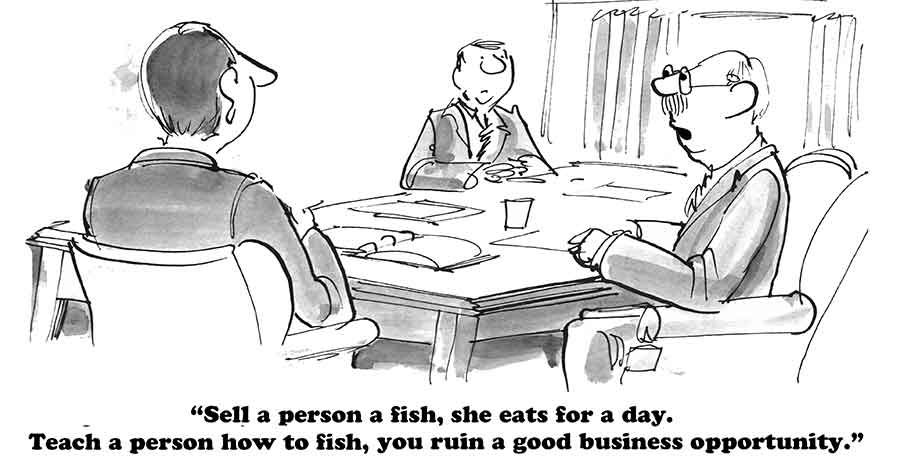For me, the most exhausting part of running a business was the endless sales cycle. First off, I sucked at sales; still do. Second, I had a nasty habit – at least in the early days of being in business – of counting handshakes as actual sales.
Whether we like it or not, starting and running a business is first and foremost a sales job. Forget all those romantic notions of being a hoity-toity CEO in the corner suite with an expense account. You’re in sales. Even if you have an entire department dedicated to sales and marketing, you will always be Salesperson #1 on your team. You will be in continual sales mode every day of your life, from those endless glad-handings at a fundraiser to the carefully rehearsed elevator pitch to potential investors.
As I have come to learn the hard way, sales isn’t about having the better product or better price. It’s all about building a relationship that establishes and builds trust. Without trust, you don’t have a sale and without a sale you don’t have a business. It’s really that simple.
So, how do you build trust, especially when you’re trying to keep food on the table?
Learn to listen.
No one wants to think they are being sold a bill of goods. If you want to make a sale, you need to start with a conversation. Learn the prospect’s business inside and out. Find the pain points. Ask a lot of questions. Listen intently. Find common ground. Sales isn’t a sprint race. It’s a marathon.
Come prepared.
Before you ever reach out to a prospect, do your homework. Show them that you have taken the time to understand their business but don’t come across as a know-it-all. Above all, be prompt, courteous and respectful of the time they are taking out of their busy day to meet with you.
It’s all about them, not you.
When you’re in the hunt, make sure that your product or service actually addresses the prospect’s problem. Don’t try to sell them something that isn’t a good fit, fails to fix the issue or make things worse. If you don’t have the right solution, be honest about it. A square peg and a round hole will never be a good fit long term. Just as my ex-wife.
Over-deliver on your promises.
When you make a promise to a prospect, make sure you deliver the goods. Finish what you start, follow up when you say you will, meet all your deadlines and return calls promptly. The impression you make during the sales cycle will tell your prospect clearly what kind of vendor or partner you will be. Trust doesn’t lie in words or promises alone. It’s the actions you take that make the difference. Err on the side of over-delivering on everything.
Don’t diss the competition.
In the heat of making a sale, it can be very tempting to throw a competitor under the bus. Resist the temptation to compare yourself with anyone and never badmouth a competitor. It only makes you look petty and your prospect will wonder what you say about them when they aren’t in the room.
Go the distance.
Sales cycles can be long and arduous, especially when it’s a high dollar item. If the prospect doesn’t buy from you immediately, realize that the timing may not be right. You have no insight into their purchasing processes, politics or available budgets. Be patient, but also be prepared to engage the prospect going now and then so they don’t forget about you. Send them a link to a blog you just came across or better yet wrote, send some new business their way, or respond to something they post on LinkedIn, even if it’s just a quick congratulations.
Know when to fold.
Every prospect won’t become a customer. Some (about 3%) are ready to buy, a larger percentage (7%) are open to buying but aren’t actively looking for something. The rest – 90% – are either indifferent, aren’t interested in making a purchase or simply aren’t going to buy anything from anyone. Yes, you need to go the distance, but you also need to know when it’s time to cut and run. Moving on allows you to find a new customer and that 10% – those ready to buy or open to buying – is your sweet spot.
Bank on it.
Finally, realize that a sale is never a sale until the funds land in your account and the customer is satisfied. A lot of great business relationships have soured because a handshake was never followed by an actual order and, more importantly, a payment. In the heat of the moment, it’s easy to become swayed by all those dollar signs dancing around in your head. But ultimately, the only sale that counts is the one where the check clears and the promise is fulfilled. Keep your head in the game, not in the clouds.
The sooner you embrace your inner salesperson, the sooner you’ll get a solid return on your investment in your company and its customers. Who knows? You may even learn to enjoy being Salesperson #1.
In the Emerald City, wishing you a New Year filled with cha-chings,
- Robb

